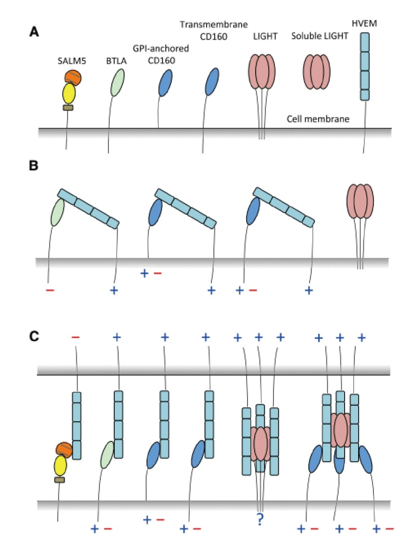
Our promise to you:
Guaranteed product quality, expert customer support.
 24x7 CUSTOMER SERVICE
24x7 CUSTOMER SERVICE
 CONTACT US TO ORDER
CONTACT US TO ORDER
CD160 Gene Editing 
CD160 is a glycosylphosphatidylinositol (GPI)-anchored protein member of the Ig superfamily with a restricted expression profile that is limited to CD56dim CD16+ NK cells, γδ T-cells, NKT-cells, cytotoxic CD8+ T-cells lacking the expression of CD28, a small fraction of CD4+ T-cells and all intraepithelial lymphocytes. Apart from its association with effector function, CD160 was demonstrated to bind broadly to MHC class I molecules with low affinity. However, a recent study showed that human CD160 binds to herpesvirus entry mediator (HVEM), a TNF family member, with a much higher affinity than to MHC class I, and results in suppressed T cell responses in vitro.
CD160:HVEM Interaction
HVEM is a prominent member of the tumor necrosis factor (TNF) receptor superfamily (TNFRSF), which binds CD160 as well as LIGHT and LTa, two members of the TNF ligand superfamily (TNFSF). The CD160:HVEM interaction elicits distinct functions on different cell types. For example, in T lymphocytes, trans engagement of HVEM and CD160 produces a coinhibitory signal that suppresses CD4+ T cell proliferation and interferon-g (IFN-g) production. In contrast, in NK cells, CD160:HVEM engagement delivers costimulatory signals to boost cytokine production and promote lytic activity, possibly through phosphorylation of AKT and ERK1/2. In the mucosal system, CD160 on innate-like intraepithelial lymphocytes interacts with epithelial HVEM to activate the Stat3-Reg3 pathways, which enhances the mucosal innate response and provides host defense against bacterial infection. CD160 and HVEM are important regulators, exhibiting multiple functional outcomes, which are sensitive to many variables, including the expression patterns on different cell types, competing for engagement of different ligands, cis versus trans interactions, and the context-dependent direction of the signaling. Therefore, therapeutic targeting of the CD160:HVEM axis for the treatment of infectious diseases, autoimmunity, and cancer has generated intense interest.
 Figure 1. The cis and trans Interaction Network of HVEM Hub. (Liu W, et al. 2019)
Figure 1. The cis and trans Interaction Network of HVEM Hub. (Liu W, et al. 2019)
CD160 and Anti-angiogenic Therapies
Recently, it was suggested that some of the NK cells from CD160-deficient mice were unable to produce IFN-γ, which is known to be involved in angiogenesis. In cultured endothelial cells, CD160 was also shown to be expressed by growing activated but not quiescent cells. Besides, its specific engagement, either by MHC class Ib molecules or by CL1-R2, an agonist murine monoclonal antibody (mAb) directed against human CD160, reduced angiogenesis by the caspase-dependent apoptosis of endothelial cells. This anti-angiogenic mechanism is thus distinct from the current anti-angiogenic therapies that target the VEGF/VEGF-R pathway. CL1-R2 treatment of mice with ischemic retinopathy was shown to restore the normal retinal vascularization, indicating that this mAb has a dual activity, as it blocks neoangiogenesis and seems to restore a normal vascular structure. Thus, CD160 could stand as a promising target for anti-angiogenic therapies.
CD160 Gene Editing Service
CRISPR/Cas9 PlatformCB at Creative Biogene is dedicated to offering comprehensive CRISPR/Cas9 gene editing services and products for academic research, biotech research and pharmaceutical drug discovery. With deep gene editing knowledge and extensive experience in experimental operation and data processing, we help you effectively control CD160 genes knockout/knockin/point mutation in cells or animals via CRISPR/Cas9 technology.
| Service | Details | Alternative cell lines or animal species |
| CD160 Gene Editing Cell Line Generation | gRNA design and synthesis Transfect the cell lines you're interested Select the high expression cells and sort monoclonal cell Validate the knockout/knockin/point mutation of CD160 by PCR and sequencing Provide cryogenic preserved vials of stable cells and final reports | HEK239T, Hela, HepG2, U87, Ba/F3, CHO, MDA-MB-453, MDA-MB-231NIH3T3, T47D, Neuro2a, MCF7, RKO, K562, RAW264.7, etc. |
| CD160 Gene Editing Animal Model Generation | CD160 gene conventional knockout animals CD160 gene conditional knockout animals CD160 point mutation animals CD160 knockin animals | Mouse, rat, rabbit, zebrafish, C. elegans, etc. |
Related Products at CRISPR/Cas9 PlatformCB
| CATALOG NO. | PRODUCT NAME | PRODUCT TYPE | INQUIRY |
| CLKO-1631 | CD160 KO Cell Lysate-HeLa | Knockout Cell Lysate | Inquiry |
| CSC-RT1782 | CD160 Knockout Cell Line-HeLa | Pre-Made Knockout Cell Line | Inquiry |
References
- Liu W, et al. Structural Basis of CD160: HVEM Recognition. Structure, 2019, 27(8): 1286-1295. e4.
- Tu T C, et al. CD160 is essential for NK-mediated IFN-γ production. Journal of Experimental Medicine, 2015, 212(3): 415-429.
- El-Far M, et al. CD160 isoforms and regulation of CD4 and CD8 T-cell responses. Journal of translational medicine, 2014, 12(1): 217.
- Henry A, et al. CD160 expression in retinal vessels is associated with retinal neovascular diseases. Investigative ophthalmology & visual science, 2018, 59(7): 2679-2686.